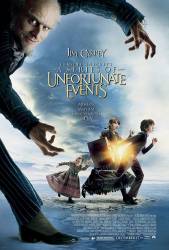Continuity mistake: When Violet writes the letter B, when she is signing the marriage certificate, the side of the B goes down with a little loop. A few shots later, in a closeup of the signature, the B is different. (01:25:00)
Continuity mistake: At the end, when the Baudelaires walks into their house, we see in a wide shot that they walk up a step on the stairs. When it cuts we see them walk up the same step again. (01:27:00)
Factual error: When the children jump off the remains of Aunt Josephine's house, they jump further than they'd be able to. The slanting floor, at least, would reduce the distance, plus they didn't take enough of a run up to jump the gap.
Other mistake: When the children run into Captain Sham (Count Olaf in disguise), Aunt Josephine says that the children will make them a meal of puttanesca. You need the stove to make puttanesca but Aunt Josephine would never let the children anywhere near the stove because she was terrified that it would burst into flames.
Continuity mistake: Watch the window switches in Count Olaf's 1960 Imperial when the orphans are on the train tracks. When Violet is speaking to Mr Poe on the car phone, the driver's side door appears to have 6 switches in a row (not completely discernible). This means the vent windows on the front doors are power operated (adding 2 switches to the usual 4, with no power lock switch). However the front passenger's side door vent has a manual latch (not used with power vents) which Violet breaks to open the window, and only one switch instead of the two needed for the main glass and vent. And as the train is passing by them, there is a shot of Klaus and Violet in the front seat, and then a lower shot of Sunny clapping her hands. Between these two shots the one switch on the passenger door becomes a set of 2. Several Imperials must have been used for filming.
Continuity mistake: When Violet and Klaus throw the anchor onto the three cylinders they use to move it, the red and white piece of wood is in the back, but when it shows Violet grabbing the last cylinder to place in the front, the decoracted cylinder that was in the middle is now in the back.
Continuity mistake: When Violet starts to read the letter from their parents, the camera cuts to a shot of the letter. The first paragraph ends with "look hard enough" and the second starts with "We hope to." When Violet reaches that point in the letter, another sentence is added in between the two.
Plot hole: During the play Klaus climbs up the side of the building to save the baby. He gets up and finds out Olaf burned their home with a giant magnifying glass. Later, Klaus uses the magnifying glass to burn the marriage certificate. This is impossible because the device couldn't have possibly been facing or forced to face the stage. The magnifying glass was on the other side of where Klaus climbed up and when he was climbing up he was facing the stage.
Continuity mistake: When Violet is signing the 'B' in her last name on the marriage certificate, she connects the 'B' below the line. The shot switches. When it switches back as Violet's signing the 'd', the 'B' is connected above the line.
Continuity mistake: When Count Olaf is driving the kids back from the custody hearing and the shot cuts from Olaf to the kids when Violet says, "Pure evil," Sunny is leaning against Violet, looking as if she is about to fall asleep. When the shot cuts back to Olaf, Sunny is sitting straight up and alert in between her siblings.
Continuity mistake: After Uncle Monty explains why they're going to Peru, he pulls back his jacket and puts his hands in his pockets, revealing the spyglass. In the next shot, his hands are behind his back, not in his pockets.






Answer: A magnifying glass concentrates all the light that goes through it at its focal point, and it is this focal point that needs to be placed on the object which one wants to set on fire. The distance of the focal point to the lens depends on the magnifying glass characteristics, and it is more than likely that Count Olaf chose a glass where the focal point would be situated exactly "37 blocks" away from his house, that is, at the Baudelaire's mansion. When trying to set on fire an object much, much closer, the glass would concentrate much, much less energy, and would only be able to set on fire easily burnt objects, such as thin paper.
AnthonyA